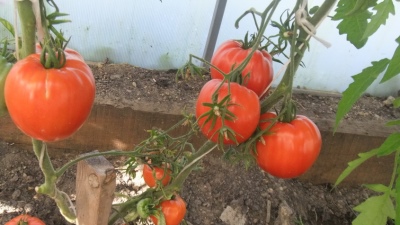
- Authors: folk selection, Minusinsk
- Category: grade
- Growth type: indeterminate
- Appointment: fresh consumption, for ketchup and tomato paste
- Ripening period: mid-season
- Growing conditions: for greenhouses
- Bush size: tall
- Bush height, cm: up to 300
- Ripe fruit color: Red
- Fruit shape: heart-shaped
Informally bred varieties can be as good choices as professionally bred varieties. Tomato Minusinskie gobies just confirms this rule. And it is all the more important to understand its key features and characteristics.
Breeding history
Minusinsk gobies are a variety of the so-called folk selection. Therefore, all recommendations for its use are purely informal. They are based only on an analysis of personal practice. It is only known that the developers of the plant live in Minusinsk. Actually, it was this circumstance that gave the main name.
Description of the variety
Minusinsk gobies are distinguished by indeterminate developmental dynamics. His bushes are not just tall, but very tall. Some specimens were recorded, reaching a height of 3 m. This plant cannot boast of anything special from a botanical point of view.
The main qualities of the fruit
Ripe berries of Minusinsk gobies are large in size. They differ in the usual red color for most tomatoes. The mass of a single fetus has a wide range, from 300 to 800 g. In shape, it resembles a stereotypical heart. One brush can supply 6 tomatoes to gardeners.
Taste characteristics
Minusinsk gobies show excellent sweetness. Their pulp contains only a small amount of seeds. At the same time, it is invariably juicy and fleshy. The glossy peel of the fruit does not produce any unpleasant effect. In general, the tasting ratings are very high: although sour notes are caught, they are subordinate in character compared to sweetness.
Ripening and fruiting
The variety belongs to the mid-season category. For him, a stretched dynamics of fruiting is typical.
Yield
The declared ability to produce 12 kg of berries per 1 m2. The collection from each bush can be 4-5 kg. These indicators are highly dependent on both agricultural technology and the actual weather.
The timing of planting seedlings and planting in the ground
It is necessary to sow seeds in planting containers approximately 60 days before transshipment to a vegetable garden or to a greenhouse. It is best to do this in the first 1-2 weeks of March. Light fertile soil is used for work.

Growing tomato seedlings is an extremely important process, because it largely depends on whether the gardener can harvest at all. All aspects must be taken into account, from seedbed preparation to planting in the ground.
Landing scheme
It is highly undesirable to plant more than 3 bushes per 1 m2. The minimum distance between the holes is 70 cm. The row spacing is made at least the same, or even increased.

Growing and caring
Tying to a support and shaping a bush will be a must for any gardener. Best of all in practice shows itself to be the conduct of this culture in 1 or 2 stems. It will also be difficult to do without eliminating redundant stepchildren. In the garden, the Minusinsk gobies tomato grows best in light fertile soil, like seedlings. The largest fruits are achieved when the plant is kept strictly in 1 stem.




A plant needs different micronutrients at each stage of growth. All fertilizers can be divided into two groups: mineral and organic. Folk remedies are often used: iodine, yeast, bird droppings, eggshells.
It is important to observe the rate and period of feeding. This also applies to folk remedies and organic fertilizers.


Resistant to adverse weather conditions
It is stated that under extreme conditions of cultivation, the variety is resistant. As always, this is achieved at the expense of the basic quality of the crop and the level of productivity. Therefore, experienced gardeners always strive to optimize the cultivation conditions.
Growing regions
No official zoning was carried out. But taking into account the region of origin, we can assume that this variety will perform well in the conditions of Eastern Siberia. He also has solid prospects in areas with a milder climate. But there you will have to develop agricultural technology on your own.
Review overview
Estimates of Minusinsk bulls from different consumers are contradictory. Some farmers mention that they only give a decent harvest from the first brush. Such disappointments are common. However, there are also opposite reviews. They mark the good taste and other valuable consumer characteristics of the crop.

























































































